
Mountain View is a city in Santa Clara County, California, United States. Named for its views of the Santa Cruz Mountains, it has a population of 82,376.

Caltrain is a California commuter rail line serving the San Francisco Peninsula and Santa Clara Valley. The southern terminus is in San Jose at Tamien station with weekday rush hour service running as far as Gilroy. The northern terminus of the line is in San Francisco at 4th and King Streets. Caltrain has 28 regular stops, one limited-service weekday-only stop, one weekend-only stop (Broadway), and one football-only stop (Stanford). While average weekday ridership in 2019 exceeded 63,000, impacts of the COVID-19 pandemic have been significant: in August 2022, Caltrain had an average weekday ridership of 18,600 passengers.
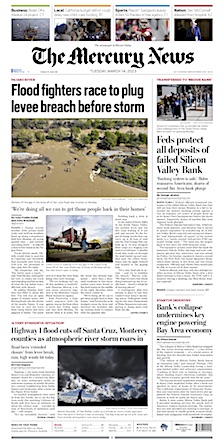
The Mercury News is a morning daily newspaper published in San Jose, California, in the San Francisco Bay Area. It is published by the Bay Area News Group, a subsidiary of Digital First Media. As of March 2013, it was the fifth largest daily newspaper in the United States, with a daily circulation of 611,194. As of 2018, the paper has a circulation of 324,500 daily and 415,200 on Sundays. As of 2021, this further declined. The Bay Area News Group no longer reports its circulation, but rather "readership". For 2021, they reported a "readership" of 312,700 adults daily.

Stanford Research Park (SRP) is a technology park established in 1951 as a joint initiative between Stanford University and the City of Palo Alto. It was the world's first university research park. It has more than 150 companies, including Hewlett-Packard, Tesla Motors, TIBCO and VMware; previously, it housed high-profile companies, including Steve Jobs's NeXT Computer, Xerox PARC, and Facebook. It has been called "an engine for Silicon Valley" and "the epicenter of Silicon Valley".

The Santa Clara Valley Transportation Authority, more commonly known simply as the Valley Transportation Authority (VTA), is a special district responsible for public transit services, congestion management, specific highway improvement projects, and countywide transportation planning for Santa Clara County, California. It serves San Jose, California, and the surrounding Silicon Valley. It is one of the governing parties for the Caltrain commuter rail line that serves the county. In 2021, the VTA's public transportation services had a combined ridership of 14,312,200, or about 71,400 per weekday as of the third quarter of 2022.
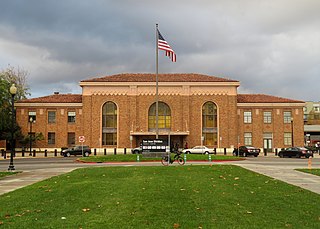
San Jose Diridon station is the central passenger rail depot for San Jose, California. It also serves as a major intermodal transit center for Santa Clara County and Silicon Valley. The station is named after former Santa Clara County Supervisor Rod Diridon.

Santa Clara Transit Center is a railway station in downtown Santa Clara, California. It is served by Caltrain, Amtrak Capitol Corridor, and Altamont Corridor Express (ACE) trains. It is the planned terminus for the Silicon Valley BART extension into Santa Clara County. The former station building, constructed in 1863 by the San Francisco and San Jose Railroad, is used by the Edward Peterman Museum of Railroad History.
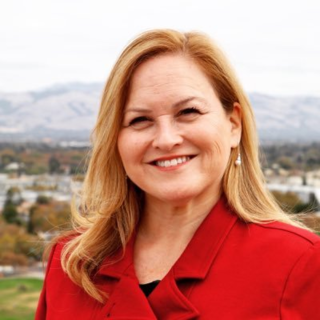
Cindy Chavez is an American politician who serves as the Santa Clara County supervisor representing district two, which is home to nearly 400,000 residents in Downtown, East, and South San Jose. Her public service career began in the 1990s as a policy analyst for health care, public health, human services and transportation for the Board of Supervisors. She served two terms on the San Jose City Council, where she was also Vice Mayor, and also served on the board leadership of public agencies such as the San Jose Redevelopment Agency, and executive director of Working Partnerships USA and the South Bay AFL-CIO Labor Council. She has unsuccessfully run for Mayor of San Jose twice. She is a graduate of San Jose State University, is married and has a son in college.

San José City Hall is the seat of the municipal government of San Jose, California. Located in Downtown San Jose, it was designed by Pritzker Prize-winning architect Richard Meier in a Postmodern style. It consists of an 18-story tower, an iconic glass rotunda, and a city council chamber wing, laid out within a two-block-long public square known as San José Civic Plaza. The tower rises 285 feet (87 m) above the plaza, making it the second tallest building in San Jose.
Throughout the history of Bay Area Rapid Transit, there have been plans to extend service to other areas.

Santa Clara County, officially the County of Santa Clara, is the sixth-most populous county in the U.S. state of California, with a population of 1,936,259, as of the 2020 census. Santa Clara County and neighboring San Benito County together form the U.S. Census Bureau's San Jose-Sunnyvale-Santa Clara metropolitan statistical area, which is part of the larger San Jose-San Francisco-Oakland combined statistical area. Santa Clara is the most populous county in the San Francisco Bay Area and in Northern California. The county seat and largest city is San Jose; with about 1,000,000 residents, it is the 10th-most populous city in the United States, California's third-most populous city and the most populous city in the San Francisco Bay Area. The second- and third-largest cities are Sunnyvale and Santa Clara.

Berryessa/North San José station is an intermodal transit center located in the Berryessa district of San Jose, California. The station is served by Bay Area Rapid Transit (BART) and Santa Clara Valley Transportation Authority (VTA) buses. The transit center opened for bus service on December 28, 2019, and subsequently for BART service on June 13, 2020.
The Silicon Valley BART extension is an ongoing effort to expand service by Bay Area Rapid Transit (BART) into Santa Clara County via the East Bay from its former terminus at the Fremont station in Alameda County. Planned since at least 1981, the project has seven stations in three sequential phases.
The South Bay Labor Council, AFL–CIO (SBLC), is the labor council of Santa Clara and San Benito counties in California's Bay Area. The SBLC is affiliated with the AFL–CIO, one of the national labor confederations of the United States. The SBLC represents over 100,000 men and women of 101 unions in Silicon Valley. The current Executive Officer is Ben Field. The organization gained public attention in the late 1990s for supporting legislative efforts to redistribute income to Silicon Valley's poor and low income residents.
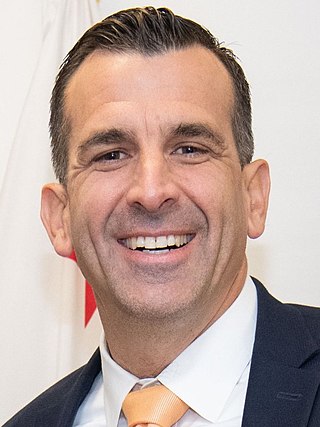
Samuel Theodore Liccardo is an American attorney and politician from California and former mayor of San José, California, a position he held from 2015 to 2023. A member of the Democratic Party, Liccardo was elected mayor in November 2014. He was reelected in 2018 with 75.8% of the vote. As the leader of the California Big City Mayors Coalition, Liccardo has advocated on statewide issues including homelessness and COVID-19 response.
Faster Bay Area is a November 2020 ballot measure proposed by a coalition of business lobbying groups to raise up to $100 billion over 40 years for transportation projects in the San Francisco Bay Area. Similar to the 2018 Regional Measure 3, the tax would require a bill to be passed by the California State Legislature authorizing its placement on ballots in all nine Bay Area counties. According to Silicon Valley Leadership Group (SVLG) CEO Carl Guardino, the goal of the tax is "to build a seamlessly integrated world-class transit system that serves the transit-dependent and lures the non-transit dependent out of their vehicles.”

Silicon Valley, a region located in the southern part of the San Francisco Bay Area, is one of the most expensive regions to live in the United States, and many residents lack access to affordable housing. In 2018, the median home price across the area was $1.18 million, the highest of the 100 largest metro areas in the U.S. The growth of the technology industry in the area, including major companies like Google, Facebook, and Apple, is frequently cited as a major cause of the issue. There have been local efforts to address affordable housing, as well as state measures in response to housing issues across California.
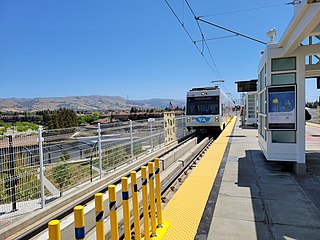
The Orange Line is a light rail line in Santa Clara County, California, and part of the Santa Clara Valley Transportation Authority (VTA) light rail system. It serves 26 stations in the cities of Mountain View, Sunnyvale, Santa Clara, San Jose, and Milpitas, traveling between Downtown Mountain View and Alum Rock stations, stopping at Ames Research Center, Great America, and Levi's Stadium along the way. The line connects to Caltrain at Mountain View and to the Bay Area Rapid Transit (BART) system at Milpitas station. The line runs for 20 hours per day on weekdays, with headways of 15 minutes for most of the day. On weekends, the train runs at 20-minute headways for most of the day. After around 8 pm on weekdays and weekends trains run at 30-minute headways.
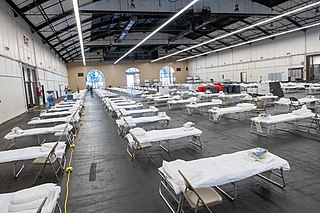
The San Francisco Bay Area, which includes the major cities of San Jose, San Francisco, and Oakland, was an early center of the COVID-19 pandemic in California. The first case of COVID-19 in the area was confirmed in Santa Clara County on January 31, 2020. A Santa Clara County resident was the earliest known death caused by COVID-19 in the United States, on February 6, suggesting that community spread of COVID-19 had been occurring long before any actual documented case. This article covers the 13 members of ABAHO, which includes the nine-county Bay Area plus the counties of Monterey, San Benito, and Santa Cruz.
The San Jose Chamber of Commerce, formerly known as the Silicon Valley Organization, is a chamber of commerce representing business interests in San Jose, California. It is the largest chamber of commerce in the Silicon Valley region. Founded in 1886, the chamber has played a role in the development of the local economy and politics.













